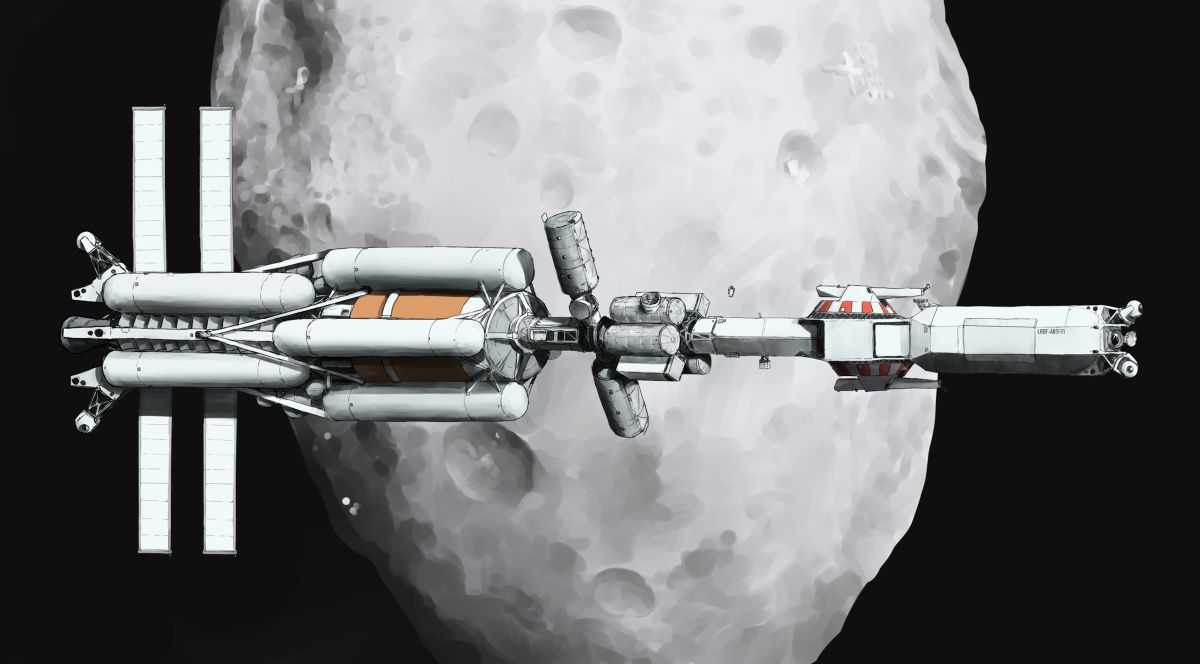Musings on Space Combat
Continuing from The Mission Control Model and The Restitution Project and the External Service, let’s talk about spaceships and how to run them. Warning: long post ahead.
Some resources to make everything below easier to use in play:
- Ship manifest (your ship’s character sheet)
- Rules cheat sheet (the rules on one page!)
Crew Stats
Spaceships have just three Stats, representing the health and competence of the crews of three departments. Roll 3d6 for them, in order. These are your Crew Stats’ maximum values — the crew at their peak performance.
- COMAST (short for communication and astrogation) oversees all interior and exterior communications, including all functions that keep the ship pointing in the right direction, sending the right signals, and seeing the right things. COMAST is the ship’s eyes, ears, and mouth.
- Engineering is responsible for all maintenance and repair needs, as well as the operation of the reactor, the maintenance of the ship’s internal atmosphere, and the management of temperature inside the ship.
- Payload keeps track of everything the ship has, uses, and needs — including weapons, if it has any. Payload maintains the ship’s cargo stores, operates its guns, and addresses any injuries the crew sustains.
To make a check, roll 1d20 under the appropriate Crew Stat. If you need to round, always round up.
Other Ship Attributes
- Hit Points: None. A successful hit will damage your Systems, lower your Crew Stats, or add Heat.
- Heat: The ship’s internal temperature. The radiators offload Heat into space, but they can only do so much.
- Heat Cap: The safe threshold for how much Heat the ship can sustain. If it exceeds the Heat Cap, the ship overheats. Base of 3d6.
- Stress: How many times the reactor has overheated. The more the ship overheats, the more dangerous it is if the ship overheats again. Starts at 0.
- Armor: Protects the ship from System damage. Base of 0 for civilian ships, 3 for warships.
- Hardpoints: Mounts for weapons, defenses, and drones. Base of 1 for civilian ships, 3 for warships.
- Cargo Holds: Bulk storage for trade goods. Each hold can store one type of good. Radioactive, hazardous, or otherwise fragile goods require specialized holds to be installed. Small items are assumed to be storable unless they require specialized storage. Base of 1 for most ships, 3 for cargo ships.
- Size: The number of modules the ship can hold. Equal to 1d4 plus the ship’s starting number of Hardpoints and Cargo Holds.
Systems
Unless specified otherwise, every ship has the following eight Systems.
| # | System | Use | If damaged or destroyed |
|---|---|---|---|
| 1 | Sensors | Detects objects in space | “Scan” is unavailable. The ship can detect other ships if they’re burning their engines, but nothing more. |
| 2 | Life Support | Keeps the ship livable for humans | “First Aid” is unavailable. Subtract 1d6 from each Crew Stat (roll separately). The crew must wear vac-suits inside the ship to survive until life support is restored. |
| 3 | Weapons Bay | Mounts weapons, drones, and defenses | “Fire” is unavailable. None of the ship’s Hardpoints can be used until the weapons bay is patched or repaired. |
| 4 | Cargo Bay | Stores cargo | Choose half of the ship’s Cargo Holds. The contents of those Holds are lost, even if the cargo bay is patched or repaired. |
| 5 | Radiators | Dispels heat | The ship’s Heat Cap is cut in half until radiators are patched or repaired. If Heat exceeds the new Heat Cap, the ship immediately overheats. |
| 6 | Thrusters | Allows the ship to maneuver | All attack rolls against the ship automatically hit. The ship can no longer rotate, change direction, or maneuver. |
| 7 | Engine | Propels the ship forward and provides gravity via acceleration | “Change Course” is unavailable. The ship loses gravity and can no longer move at more than a snail’s pace. |
| 8 | Reactor | Powers the ship | The ship loses power; choose one other System to keep online with emergency backup power. Every other System is deactivated until the reactor is patched or repaired. |
For each point of System damage the ship receives, roll 1d8 and see which System is hit by the attack. Duplicates are re-rolled.
The first time a System is hit by an attack, it is damaged and rendered nonfunctional. Damaged Systems can be patched, but this only works once — if a System is hit again, it is destroyed and must be repaired at port.
Actions
When things get tense between spaceships, actions start resolving simultaneously. Time is split into Rounds. Each Round, the Referee describes what’s happening and what the other ships are doing. The players then decide what their ship does in response.
A ship can perform two actions each Round.
| Action | Description |
|---|---|
| Patch System | Make an Engineering check to patch a damaged system. |
| Dump Radiator Coolant | Reduce your Heat by 2d6, and reduce your Heat Cap by half that result until the radiators are repaired at port. |
| Scan | Choose passive or active sensors and make a COMAST check to detect, identify, or target lock. |
| Change Course | Move from one range band to an adjacent one. If two ships are Changing Course in the same direction, the pursuer makes a COMAST check. |
| Fire | Make a Payload check to activate a Hardpoint — make a weapon attack, use a defense, or deploy a drone. Each Hardpoint can only be activated once per turn. |
| First Aid | Make a Payload check to restore 1d6 to a Crew Stat (up to its maximum). |
Range Bands
Encounters and battles in outer space take place at distances of tens of thousands, hundreds of thousands, or even millions of kilometers. At these ranges, the speed of light imposes limits on the ability to keep real-time track of faraway objects. There are four range bands:
- The Outer Envelope — within about ten light-seconds — is the far bound of where an encounter occurs. At this range, it is perfectly possible for a ship to disengage at will. Only missiles can be fired at this range. Target lock is impossible at this range, and ships lose target lock if they retreat out to the Outer Envelope.
- The Inner Envelope — within about one light-second — is where most battles actually take place. This is where target locking becomes possible, and where all weapons come into play (although lasers only deal half Heat in the Inner Envelope).
- Close Range is even shorter — within about a tenth of a light-second. Battles in Close Range are typically brief and brutal, with staggering casualties on both sides.
- Point-Blank Range is close enough to where one ship could hit another with its point-defense systems.
Sensors and Detection
There are two types of sensors. Passive sensors include telescopes and heat sensors, and only detect emissions from the target. Active sensors include radar and lidar, emitting electromagnetic radiation and detecting the radiation reflected off the target. Active sensors are more powerful, but more conspicuous.
There are three levels of detection, ranging from weakest to strongest. Each level of detection builds on the last one. To target lock a ship, it is necessary first to have identified it.
- Detection is the knowledge that something out there is hotter than background space. You know roughly what direction it’s in, how far away it is, and what sort of object it is — a ship, space station, asteroid, missile, etc. So long as you have functional sensors, you automatically and always detect any object that could possibly be of importance.
- Identification is the precise and certain localization of an object in space. If it’s a ship, you know what type it is, and you become aware of any actions it’s taking. To identify a target, you can either make a COMAST check using passive sensors, or use active sensors to identify the target without making a check. If you use active sensors to identify a target, the target also identifies you.
- Target lock is the calculation of where to train your guns so you can hit the object. This requires that you be close enough so that light lag becomes irrelevant. To target lock, you have to make a COMAST check. This uses active sensors and causes the target to identify your ship. You cannot roll to target lock in the Outer Envelope, and any ship that retreats to the Outer Envelope loses its target lock.
Attacks, Weapons, and Heat
To make an attack, choose a Hardpoint with a weapon and make a Payload check. If you haven’t locked onto your target using sensors, that check has Disadvantage.
Ships’ weapons are categorized into three types.
- Ballistics propel solid metal slugs at incredibly high speeds, tearing through an enemy ship’s hull. Ballistics can be fired at any range except the Outer Envelope.
- Lasers deal Heat rather than System damage. While devastating up close, lasers suffer from diffraction at a distance — they can be fired at any range except the Outer Envelope, but deal half Heat against targets in the Inner Envelope.
- Missiles are slow warheads outfitted with a computer package that allows them to track their target. Unlike ballistics and lasers, missile weapons consume missile ammunition when fired. Missiles can be fired at any range, but do not hit until the end of the next Round. Missile attacks do not require a Payload check or a target lock; they are presumed to hit automatically unless interdicted or destroyed en route.
System damage refers to the number of Systems hit by an attack. Armor absorbs System damage — if an attack inflicts System damage of 3, and the target has an Armor of 2, then the target’s Armor is reduced to 0 and only 1 System is hit.
Heat, meanwhile, causes no problems so long as it remains at or below the Heat Cap. Once Heat exceeds the Cap, however, the ship overheats. Roll 1d6 on the overheating table below, and add your current level of Stress. Then, gain 1 Stress, clear your Heat, and add back the excess Heat you gained above your Heat Cap.
| # | Result |
|---|---|
| 1-2 | HEATSTROKE. Internal temperature exceeds safe limits. Subtract 1d6 from each Crew Stat (roll separately). |
| 3-4 | THERMAL SHUTDOWN. Rising temperature harms electrical equipment. Subtract 1d6 from each Crew Stat (roll separately). All checks you make until the end of the next Round have Disadvantage. |
| 5-6 | UNSTABLE REACTOR. Magnets supporting the fusion reactor become unstable. Subtract 1d6 from each Crew Stat (roll separately). Then take System damage to the reactor. |
| 7+ | MASS CASUALTIES. Internal temperature becomes critical. Subtract 2d6 from each Crew Stat (roll separately). |
At the end of a battle, reduce each Crew Stat maximum by half the damage taken to the Stat.
Drones and Defenses
Drones are small, stripped-down, AI-piloted spacecraft. They have a limited number of actions available. Drones have no Crew Stats — they make all checks by rolling 1d20 and attempting to roll below 11. If a drone takes System damage, it is destroyed. A drone is also destroyed if it takes more than 5 Heat in a Round.
Drones share their levels of detection with each other and their parent ship. If a drone target locks an enemy ship, its parent ship and all sibling drones can benefit from it even in the Outer Envelope.
Sample Weapons
Primary Mass Driver
Ballistic weapon. 1 System damage. 2 damage to a Crew Stat of the target’s choosing. Take 2 Heat when firing this weapon.
Heavy Kinetic Batteries
Ballistic weapon. 2 System damage. 4 damage to a Crew Stat of the target’s choosing. Take 1d6 Heat when firing this weapon.
Basic Laser
Laser weapon. 1d6 Heat. Take 2 Heat when firing this weapon.
Multi-Laser Array
Laser weapon. 2d6 Heat, or 4 Heat on miss. Take 4 Heat when firing this weapon.
Spinal Mount Laser
Laser weapon. 3d6 Heat. Take 4 Heat when firing this weapon. Takes up 2 Hardpoints.
Ship-to-Ship Missiles
Missile weapon. 2 System damage. 2 damage to a Crew Stat of the target’s choosing. Consumes 1 missile ammunition. Take 2 Heat when firing this weapon.
Anti-Capital Missiles
Missile weapon. 1d4 System damage. 4 damage to a Crew Stat of the target’s choosing. Consumes 1 missile ammunition. Take 1d6 Heat when firing this weapon.
Point-Defense Turrets
As defense: Can stop 1 missile when fired. Take 4 Heat when using this defense.
As weapon: Ballistic weapon. 1d4 System damage. Take 4 Heat when firing this weapon. Point-Blank Range only.
Point-Defense Laser Grid
As defense: Can stop up to 2 missiles (roll for each missile). Take 4 Heat when using this defense.
As weapon: Laser weapon. 3d6 Heat. Take 4 Heat when firing this weapon. Point-Blank Range only.
Surveillance Drone
Can take the following actions:
Change Course. Move from one range band to an adjacent one. It makes a check if it’s pursuing a spacecraft moving away from it.
Scan. Choose passive or active sensors and make a check to detect, identify, or target lock.
Ram. Hit a target and destroy the drone. Can stop 1 missile from hitting the parent ship.
Combat Drone - Ballistic
Armor of 2. Can take the following actions:
Change Course. Move from one range band to an adjacent one. It makes a check if it’s pursuing a spacecraft moving away from it.
Fire. Ballistic weapon. 1 System damage. 2 damage to a Crew Stat of the target’s choosing.
Ram. Hit a target and destroy the drone. Can stop 1 missile from hitting the parent ship.
Combat Drone - Laser
Armor of 2. Can take the following actions:
Change Course. Move from one range band to an adjacent one. It makes a check if it’s pursuing a spacecraft moving away from it.
Fire. Laser weapon. 1d6 Heat.
Ram. Hit a target and destroy the drone. Can stop 1 missile from hitting the parent ship.
Defensive Drone Swarm
Can take the following actions:
Fire. Defense. Can stop 2 missiles from hitting the parent ship (roll for each missile).
Ram. Hit a target and destroy the drone. Can stop 1 missile from hitting the parent ship.
Modules
Some ships come equipped with extra modules — expansions to the ship that give it extra functionality. A ship can hold a number of modules equal to its Size. Its Hardpoints and Cargo Holds count toward this total. Some sample modules include:
- Extra Hardpoint: Adds 1 Hardpoint to the ship.
- Extra Cargo Hold: Adds 1 Cargo Hold to the ship.
- Reinforced Radiators: If the radiators are damaged, reduce Heat Cap by a quarter, rather than by half.
- Passenger Quarters: Cramped, minimal, but serviceable rooms and common areas, which can carry up to 100 passengers on long trips across the Solar System.
- Luxury Cabins: Spacious quarters which can carry up to 25 passengers in first-class comfort.
- Lander: A small auxiliary spacecraft capable of landing on the surfaces of moons and planets. Up to 10 people may be safely carried.
- Armory: Storage for enough military weaponry and armor to equip 25 people.
- Mining Equipment: Drills, harpoons, drones, inflatable domes, storage pods, and other gear for harvesting valuable materials from asteroids.
- Fuel Scoop: This ship can skim the atmosphere of a gas giant to harvest atmospheric gasses for refining or sale. Choose a Cargo Hold to be optimized for carrying condensed gasses.
- Smuggler’s Hold: A hidden compartment the size of one Cargo Hold, where goods or people can be stored discreetly.
- Medical Bay: This ship is outfitted with expanded facilities for treating injured patients. When taking the First Aid action, you may restore 2d6 to one Crew Stat, or 1d6 to two.
- Electronic Warfare Package: Gain an action, Breach Network. Make a COMAST check to choose or negate one of the target ship’s actions that Round. This check always has Disadvantage.
Some ships are designed for only local travel, such as between the moons of Jupiter or Saturn, or around the Asteroid Belt. In that case, they might be equipped with a chemical fuel engine. For these ships, add the following module:
Chemical Fuel Engine: Instead of having a nuclear fusion reactor, this ship burns liquid propellant to accelerate. This ship has Fuel, which starts at 3 (its maximum is also 3). Local journeys cost 1 Fuel. Longer trips, such as between planets, cost 3 Fuel. Additionally, replace the Reactor System with Fuel Tanks. If the fuel tanks are damaged or destroyed, the ship’s current and maximum Fuel decrease by 1. This module does not count against the ship’s Size.
Flaws
Salvaged, derelict, or otherwise ramshackle spaceships might come with a flaw — some kind of mechanical weakness in the ship. Example flaws include:
- Faulty System: Roll 1d8 on the System chart. That System cannot be patched — if it’s damaged, it’s destroyed and must be repaired at port.
- Fire Risk: Whenever the ship takes Heat, roll 1d10. On a 10, an electrical fire breaks out, causing 1d6 damage to a Crew Stat of your choosing. In combat, the ship must spend one of its actions next Round to put out the fire.
- Outdated Reactor: The ship’s Stress starts at 2 and cannot be decreased below 2.
- Unusually Small: Reduce the ship’s starting number of either Hardpoints or Cargo Holds by 1. The ship’s Size is equal to the number of Hardpoints and Cargo Holds, plus 1.
- Weak Hull: The ship’s Armor cannot be increased above 2.
- Bad Sensors: Identification using active sensors requires a COMAST check. All other Scan checks have Disadvantage.
The Transponder
A transponder is a radio beacon fixed to every spaceship, providing the vessel’s unique identification whenever prompted. By law, civilian spaceships are required to have their transponder switched on at all times. Military spacecraft often have their transponders switched off or tuned to only respond to requests containing a secret activation code.
Transponders are difficult but not impossible to tamper with. A transponder might be manipulated to broadcast fake identification.
How to Roll Up a Ship
- Roll 3d6 for each Crew Stat (if it has crew).
- Roll 3d6 for Heat Cap. Set Stress to 0.
- Set Armor to 3 if it’s a warship, 0 otherwise.
- Set Cargo Holds to 3 if it’s a cargo ship, 1 otherwise.
- Set Hardpoints to 3 if it’s a warship, 0 otherwise.
- Roll 1d4 + the number of Cargo Holds and Hardpoints for Size.
- Pick out some weapons, or don’t, if the ship is unarmed. If you picked a missile weapon, set missile ammunition to 3.
- Roll 1d12 or pick a Module if it’s a fancy, expensive, or specialized ship.
- Roll 1d6 or pick a Flaw if it’s a derelict, salvaged, or outdated ship.
Sample Ships
The Lyra
This small mining vessel was practically cobbled together in someone’s garage. Its chemical fuel engine is powerful enough for local flights in the Asteroid Belt, but not much more. The ship is equipped with a mass driver to ward off pirates and claim jumpers.
COMAST: 10
Engineering: 13
Payload: 9
Heat Cap: 7
Armor: 0
Fuel: 3
Cargo Holds: 1
Hardpoints: 1
- Primary Mass Driver
Size: 4
Modules:
- Mining Equipment
- Chemical Fuel Engine
Flaws:
- Faulty System (thrusters)
The Boomslang
A decommissioned hospital ship, stolen by a group of pirates and outfitted with a slate of offensive weapons to threaten cargo freighters and mining vessels.
COMAST: 8
Engineering: 13
Payload: 7
Heat Cap: 13
Armor: 0
Missiles: 3
Cargo Holds: 1
Hardpoints: 2
- Basic Laser
- Ship-to-Ship Missiles
Size: 4
Modules:
- Extra Hardpoint
- Lander
Flaws:
- Fire Risk
The Taurus
An interplanetary cargo ship of the Ceravolo Gas & Freight company. Designed for long hauls across the Outer Solar System, the ship has plenty of space for carrying atmospheric gasses, and its short-range point-defense guns scare off pirates looking to plunder such a high-value target.
COMAST: 8
Engineering: 12
Payload: 11
Heat Cap: 9
Armor: 0
Cargo Holds: 4 (3 are specialized for compressed atmospheric gasses)
Hardpoints: 1
- Point-Defense Turrets
Size: 7
Modules:
- Extra Cargo Hold
ENS Friedrich Barbarossa
Staufer-class fast-attack frigate of the External Navy. Long-range missiles force the enemy to generate heat in the outer envelope, while its kinetic batteries wreak havoc in the short and medium ranges.
COMAST: 14
Engineering: 10
Payload: 12
Heat Cap: 10
Armor: 3
Missiles: 3
Cargo Holds: 1
Hardpoints: 3
- Heavy Kinetic Batteries
- Ship-to-Ship Missiles
- Point-Defense Laser Grid
Size: 5
Modules:
- Electronic Warfare Package
ENS Sikasso
Wagadou-class laser-mounted gunship of the External Navy. The ship itself is built around a massive laser cannon, a devastating weapon at small distances.
COMAST: 9
Engineering: 11
Payload: 12
Heat Cap: 15
Armor: 3
Cargo Holds: 1
Hardpoints: 4
- Spinal Mount Laser
- Primary Mass Driver
- Point-Defense Laser Grid
Size: 7
Modules:
- Extra Hardpoint
- Reinforced Radiators
ENS Oneida
Haudenosaunee-class drone mothership of the External Navy. Unarmored by itself, the ship instead carries a suite of combat and reconnaissance drones.
COMAST: 9
Engineering: 16
Payload: 9
Heat Cap: 13
Armor: 3
Cargo Holds: 1
Hardpoints: 4
Surveillance Drone
- Combat Drone - Ballistic
- Combat Drone - Laser
- Defensive Drone Swarm
Size: 6
Modules:
- Extra Hardpoint
Design Notes
- This is my sixth attempt at writing spaceship rules, and the first draft I feel is play-ready.
- I haven’t playtested these rules at all. I don’t know if any of this works. I’m going to try to get some friends together to play soon. I might write a follow-up post reporting back on how that goes.
- I don’t have “ship roles” — the players all act as a single unit when they’re in control of their ship. This does a few things that I like. For one, nobody’s sitting around because there are, say, six player characters and only five roles to fulfill on the ship. Nobody’s left out because they didn’t take a Piloting or Gunnery skill during character creation. And tonally, the focus is on the crew’s collective cohesion and competence, not the heroism of any one person.
- I left out a “Command” Crew Stat because I think in most situations, the PCs are the Command staff. I might add it in later, and I have some ideas for how I’d do it, but nothing firm yet. Let’s get the basics down first.
- I did two actions per Round for a few reasons. For one, it feels right that multiple organs of the ship are acting simultaneously. One department is doing one thing, another department is doing another thing, the whole ship is one big complex organism. It also avoids a situation where the only thing a ship ever does is fire its gun. So now you can shoot at the other ship and use sensors, or patch a system, or do first aid.
- I emphasized rolling up a ship because I think it’s more dramatic if the player characters acquire or stumble upon a ship during play. They don’t get to choose all the details — they have to work with what they’ve got.
Further Reading
- Space Weapons Intro
- Space War Intro
- Detection in Space Warfare
- The Big List of Propulsion Failures II
- Non-Standard Starship Scuffles
- Spaceship as Character
- Into The Void: Starships for Into The Odd
- Space Campaign Orbital Encounters
- Getting Rid of Dogfights
- No-Initiative Action for Mothership



